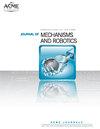A Compliant Manipulator for Confined Space Tissue Diagnostics: Kinematic and Force Analyses and Initial Characterization Experiments
IF 3.2
4区 计算机科学
Q2 ENGINEERING, MECHANICAL
Journal of Mechanisms and Robotics-Transactions of the Asme
Pub Date : 2023-06-19
DOI:10.1115/1.4062762
引用次数: 0
Abstract
Minimally invasive procedures employ continuum manipulators, however internal human anatomy presents challenges relating to size, dexterity, and workspace for these manipulators. This manuscript presents modeling, kinematic analysis, prototyping, and characterization of a micro-robotic manipulator for transurethral palpation of bladder tissue. The proposed micro-robot consists of two subsystems: a tendon-driven continuum segment with an elastic tube encompassing each joint for compliance and structural integrity, and a hyper-spherical joint ensuring higher dexterity and manipulability with a comprehensive actuation and modeling approach. The forward kinematics follow the Denavit-Hartenberg formulation. A developed differential Jacobian inverse kinematics formulation prevents motion singularities for desired poses while operating in the confined space. The simulated kinematic results confirm the dexterity and reach of the proposed micro-robot. A strain energy quasi-static model is developed for a single continuum module. The model is evaluated for tension-bend angle relationships as function of tube material and geometry, and joint length. Limited functionality continuum modules (4mm outside diameter) with four different joint lengths, (3, 6, 9, 12) mm, are prototyped for tension-bend angle characterization using a computer vision outfitted experimental setup. An equivalent shear modulus relationship for the elastic tube for selected joint length values and bend angles is developed using experimental results. The tension-bend angle response is nonlinear and function of tube properties, joint geometry, and their interactions. The comparison of the experimental and quasi-static model results shows high fidelity for use in predicting the robot continuum segment behavior.用于受限空间组织诊断的柔性机械手:运动学和力分析以及初始表征实验
微创手术采用连续操作器,但人体内部解剖结构对这些操作器的尺寸、灵活性和工作空间提出了挑战。本文介绍了用于经尿道膀胱组织触诊的微型机器人机械手的建模、运动学分析、原型设计和表征。所提出的微型机器人由两个子系统组成:一个是肌腱驱动的连续体,每个关节都有一个弹性管,以实现柔性和结构完整性;另一个是超球形关节,通过全面的驱动和建模方法确保更高的灵活性和可操作性。正向运动学遵循Denavit-Hartenberg公式。一种改进的微分雅可比逆运动学公式可以防止在受限空间中操作时所需姿态的运动奇异性。仿真运动学结果证实了所提出的微型机器人的灵活性和可达性。针对单个连续体模块,建立了应变能准静态模型。该模型的拉伸-弯曲角度关系是管道材料和几何形状以及接头长度的函数。具有四种不同接头长度(3、6、9、12)mm的有限功能连续体模块(外径4mm)是使用配备计算机视觉的实验装置进行拉伸-弯曲角度表征的原型。利用实验结果,建立了选定接头长度值和弯曲角度下弹性管的等效剪切模量关系。拉伸-弯曲角度响应是非线性的,是管道特性、接头几何形状及其相互作用的函数。实验和准静态模型结果的比较表明,在预测机器人连续体分段行为时具有高保真度。
本文章由计算机程序翻译,如有差异,请以英文原文为准。
求助全文
约1分钟内获得全文
求助全文
来源期刊

Journal of Mechanisms and Robotics-Transactions of the Asme
ENGINEERING, MECHANICAL-ROBOTICS
CiteScore
5.60
自引率
15.40%
发文量
131
审稿时长
4.5 months
期刊介绍:
Fundamental theory, algorithms, design, manufacture, and experimental validation for mechanisms and robots; Theoretical and applied kinematics; Mechanism synthesis and design; Analysis and design of robot manipulators, hands and legs, soft robotics, compliant mechanisms, origami and folded robots, printed robots, and haptic devices; Novel fabrication; Actuation and control techniques for mechanisms and robotics; Bio-inspired approaches to mechanism and robot design; Mechanics and design of micro- and nano-scale devices.
 求助内容:
求助内容: 应助结果提醒方式:
应助结果提醒方式:


